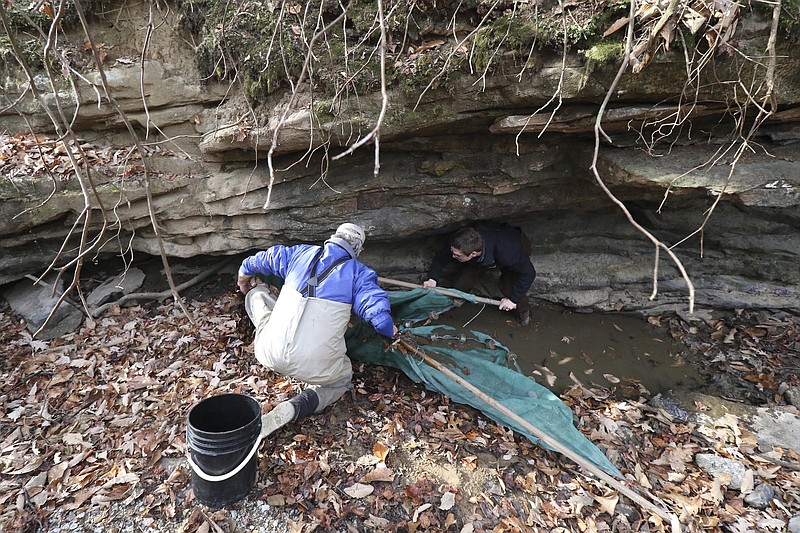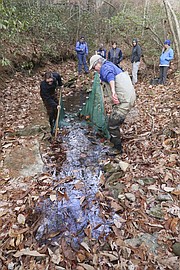LUMINARY, Tenn. - Bernie Kuhajda picked up his side of a long, two-handled fishing net and prepared to pull it once again through the shallow remnants of the cold, mountain stream with a Tennessee Aquarium co-worker.
"Come on, laurel dace," Kuhajda said with nervous optimism. "Be there, I know you can do it. I have faith in you."
Here in rural Bledsoe County, water of all types is scarce because of the drought.
Officials had to deliver emergency shipments of water to residents with dry wells this month, and there is concern, too, about how the drought is affecting an endangered fish species that lives exclusively on the Cumberland Plateau.
The laurel dace is a small fish - the largest are just 3 inches long - but it's a big priority for Kuhajda and the aquarium's freshwater conservation institute.
The little swimmers inhabit just six bodies of water and have been considered endangered since 2011.
If Kuhajda, an aquatic conservation biologist, were king for a day, he said he would regulate farming practices that allow unnatural levels of water and herbicide to flow the creeks and harm delicate species like the laurel dace.
Since he is not king, Kuhajda and his team are doing what they can to ensure that a stream named Lick Branch does not get crossed off the list of places where these rare creatures live.
"They're fairly persnickety in their habitat preferences," Kuhajda said as he stood on the rocks of Lick Branch, wearing waders in a sign of faith there would still be water in the creek. "They need a certain amount of flow. They need a certain amount of depth. They prefer the creek bottom underneath them to be a certain way.
"That's probably what's going on with the laurel dace. They're more specialists, and therefore, if the environment they evolved in changes dramatically in a short period of time, they have a hard time adjusting."
On this day, Kuhajda and his team moved east to Bumbee Creek in the afternoon and found 17 laurel dace with relative ease there in more stable waters.
Back at Lick Branch, hours of combing through the water with the net yielded just one, small laurel dace, found after more than an hour of hopping from leafy pool to leafy pool in the mostly dry creek bed. This was the same area in which they had found several of the fish with ease back in the summer.
"So Bernie, are we really bringing back one fish from here?" aquarium propagation specialist Clay Raines asked.
His team chuckled at the question.
"Yeah," Kuhajda said. "We are. He's not real happy here right now."
If things were extremely critical, Kuhajda said, they would have spent all day in Lick Branch searching for more laurel dace. But with at least one found, more water than expected still remaining in the creek and a little bit of rain in the forecast, he believed the species would be OK for the rest of the year.
The tiny fish would be taken to an aquarium facility for genetic testing. If its genetics are close enough to those of the laurel dace in Bumbee Creek, some of the fish from that creek could be introduced to Lick Branch to help its numbers, if needed.
Warren Stiles, an aquatic recovery biologist for the U.S. Fish and Wildlife Service, tagged along on the Lick Branch excursion, helping Kuhajda and Raines with the net and with trying to identify the laurel dace among their more common blacknose dace counterparts.
"This fish is in six little watersheds on Walden's Ridge and nowhere else in the world," Stiles said. "That's incredible. That's important.
"It's something that's a part of this ecosystem."
Contact staff writer David Cobb at dcobb@timesfreepress.com or 423-757-6249.

